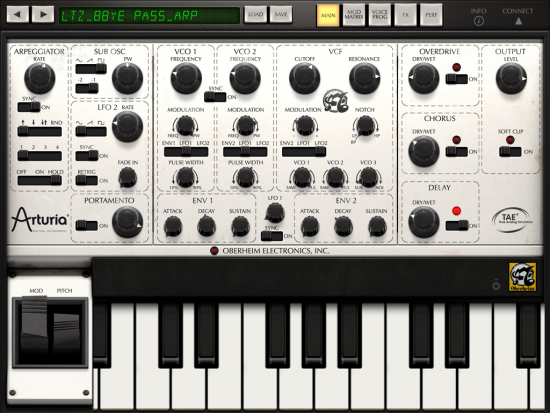Originally known for their excellent software plug-ins spanning a variety of analog synthesizers from the 70s, Arturia has recently branched out into hardware synths, controllers, and drum machines in addition to the first iOS versions of their software products. Their iSEM app for the iPad is great rendition of Oberheim’s first commercial synthesizer, the SEM. The app features a great sound, a modulation matrix, and a timed voice programmer adding a measure of motion to synth patches.
Arturia iSEM for the iPad Features
- Two Oscillators (Saw, PWM) with Sub OSC
- Polyphonic Support
- VCF, VCA with Two Envelopes
- Arpeggiator, and 8 Voice Programmer
- Overdrive, Chorus, and Delay
- 8 x Modulation Matrix
- Support for Audiobus, Inter App Audio, Core MIDI and WIST
- Available at the App Store for $9.99
The iSEM is excellent enhancement of the original Oberheim model. It’s an easy to use app with that great virtual analog sound typical of Arturia’s desktop synths.
A Unique Synthesizer Architecture
The iSEM interface beautifully represents an expanded version of the original SEM. Anyone familiar with Arturia’s desktop plug-ins or their iMini iOS app will feel right at home. A menu bar at the top of the screen handles patch management, screen navigation, in addition to MIDI and system connections.

The main screen features the VCO, VCF, SUB OSC and envelope sections. The arpeggiator and effects can also be controlled from this screen in addition to others throughout the interface.
Dual oscillators are syncable, with two knobs to control their frequency. There are separate knobs for the pulse width percentage as well as for changing between frequency and pulse width. The latter can also be modulated using the envelopes or LFOs, allowing for an interesting array of “living” sounds.
An easy-to-use 8 channel modulation matrix takes up the next screen. The sources include the obvious: LFO, Envelopes, Pitch Bend, Mod Wheel, Velocity, and a recent app update added Aftertouch. They control a rich variety of synth parameters.
I had the most fun with 8 Voice Programmer section. When synched to the arpeggiator, it is possible to modulate a host of synth parameters in time, adding greatly to the sense of motion in a synth patch. It is also possible to switch off certain voices, giving the feel of an arpeggiated run in an odd time signature.
Other screens provide more precise control of the effects and arpeggiator. The “Perf” screen also features four programmable sliders that can be assigned to a wide range of synth and effects parameters.
Support for IAA, Audiobus, and More
Support for most iOS music app standards includes Audiobus, Inter App Audio, WIST, and Core MIDI. My Griffin StudioConnect easily controlled the app using a MIDI keyboard. Control mapping was a breeze using the app’s MIDI LEARN function.
The iSEM cut through nicely through an entire band mix and inspired us into some interesting electronic spacerock improvisation that will see the light of day some year.
Arturia’s success in software synthesis translates nicely to the iOS platform and the iPad’s screen. Here’s hoping an iCS-80 or an iARP2600 is in their development pipeline. The iSEM is recommended for fans of Oberheim’s bass heavy analog synth design and for anyone interested in classic virtual analog synthesis on a tablet.

Pingback: The Arturia iMini brings Classic Bob Moog Sound to the iPad | TabMuse -- a Home for Digital and Analog Music Inspiration
Pingback: Virtual Dispatches from Musikmesse 2014 and Other News | TabMuse -- a Home for Digital and Analog Music Inspiration
Pingback: Audiobus 2 Update adds great Features to this iPad Music App | TabMuse -- a Home for Digital and Analog Music Inspiration
Pingback: Audiobus 2 -- Checking out Multi-Routing on an iPad 2 | TabMuse -- a Home for Digital and Analog Music Inspiration